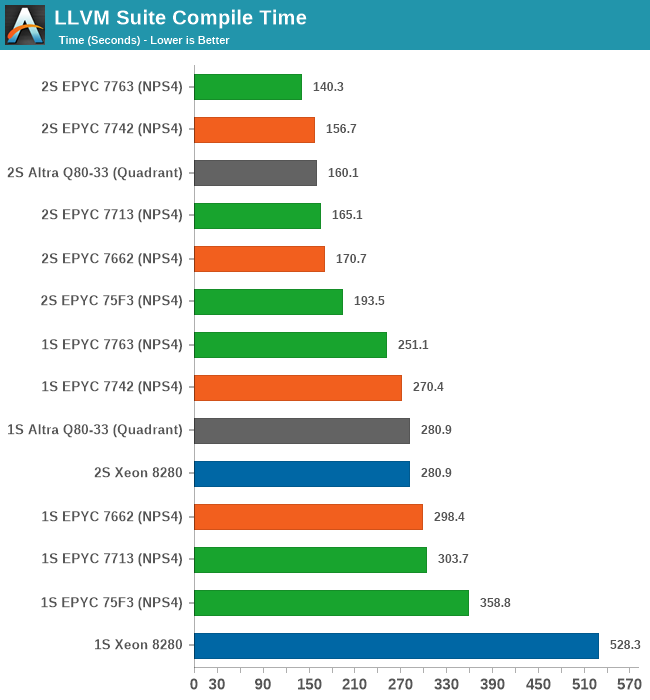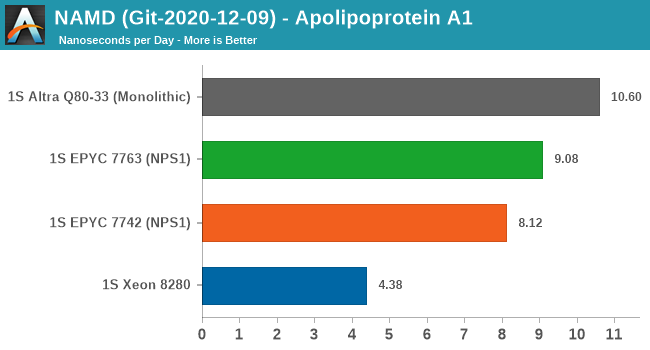AMD 3rd Gen EPYC Milan Review: A Peak vs Per Core Performance Balance
by Dr. Ian Cutress & Andrei Frumusanu on March 15, 2021 11:00 AM ESTDisclaimer June 25th: The benchmark figures in this review have been superseded by our second follow-up Milan review article, where we observe improved performance figures on a production platform compared to AMD’s reference system in this piece.
Compiling LLVM, NAMD Performance
As we’re trying to rebuild our server test suite piece by piece – and there’s still a lot of work go ahead to get a good representative “real world” set of workloads, one more highly desired benchmark amongst readers was a more realistic compilation suite. Chrome and LLVM codebases being the most requested, I landed on LLVM as it’s fairly easy to set up and straightforward.
git clone https://github.com/llvm/llvm-project.gitcd llvm-projectgit checkout release/11.xmkdir ./buildcd ..mkdir llvm-project-tmpfssudo mount -t tmpfs -o size=10G,mode=1777 tmpfs ./llvm-project-tmpfscp -r llvm-project/* llvm-project-tmpfscd ./llvm-project-tmpfs/buildcmake -G Ninja \ -DLLVM_ENABLE_PROJECTS="clang;libcxx;libcxxabi;lldb;compiler-rt;lld" \ -DCMAKE_BUILD_TYPE=Release ../llvmtime cmake --build .We’re using the LLVM 11.0.0 release as the build target version, and we’re compiling Clang, libc++abi, LLDB, Compiler-RT and LLD using GCC 10.2 (self-compiled). To avoid any concerns about I/O we’re building things on a ramdisk. We’re measuring the actual build time and don’t include the configuration phase as usually in the real world that doesn’t happen repeatedly.

For the new Milan chips, the results are a bit mixed. The higher-power 7763 takes a lead with a +10.5% improvement over the 7742, however the 7713 doesn’t manage to keep up with that predecessor.
The 1S vs 2S scores are interesting as the 2S figures showcase the new Milan chips in a better light due to the higher single-threaded performance of the Zen3 cores. The compilation here also has linking phases which are single-thread performance bottle-necked. This results in scenarios such as the 7713 losing to the 7662 in 1S comparisons, however winning out against the same chip in the 2S comparison, as it’s able to make that advantage count for more.
It’s also great to see the 75F3 keep up with the 64-core counterparts at around 72% of the top-SKU performance.

Finally, in NAMD, this is more of a core-local compute workload. We see the 7763 outperform the 7742 by +11.8%, however the Milan chip is still outperformed by the higher core compute capacity of the 80-core Altra chip.
Generally, I have my reservations about NAMD as a benchmark due to its multicore vs MPI variants and scaling anomalies, on top of the whole topic of the benchmark having a completely different algorithm for AVX512 processors.










120 Comments
View All Comments
Casper42 - Monday, March 15, 2021 - link
I'd really like to see you all test a 7543 to compare against the 75F3.If the Per Thread performance (Page 8) of that chip can beat the 7713, it might be a great option for VMware environments where folks want to stick to a single license/socket without needing the beastly 75F3
Casper42 - Monday, March 15, 2021 - link
PS: I think it will also help come April and I hope you test multiple 32c offerings then too.Olaf van der Spek - Monday, March 15, 2021 - link
Why don't these parts boost to 4.5 - 5 GHz when using only one or two cores like the desktop parts?ishould - Monday, March 15, 2021 - link
Hoping to get an answer to this tooCalin - Tuesday, March 16, 2021 - link
Basically if you have three servers at 50% load you shut one off and now deliver power to only two servers running at 75% load.An idle server will consume 100+ watts (as high idle power is not an issue for server farms) - so by running two servers at 75% versus three at 50% you basically save 100 watts.
(in many cases, server farms are actually power - i.e. electrical energy delivery or cooling - limited).
coschizza - Monday, March 15, 2021 - link
stabilityJon Tseng - Monday, March 15, 2021 - link
Probably something to do with thermals + reliability - recall in the datacenter theres a bunch of server blades stuffed into racks. Plus they are running 24/7. Plus the cooling system isn't generally as robust as on a desktop (costs electricity to run). Bottom line is that server parts tend to run at lower clocks than desktop parts for a mix of all of these reasons.Targon - Monday, March 15, 2021 - link
Server processors are NOT workstations, they are not intended for tiny workloads where there might only be a few things going on at one time. if you want more cores but want to use the machine like a workstation, you go Threadripper.yeeeeman - Monday, March 15, 2021 - link
quite underwhelming tbh..ballsystemlord - Monday, March 15, 2021 - link
You expected? AMD has been overwhelming for years now, give them some slack. They can't do it every year.